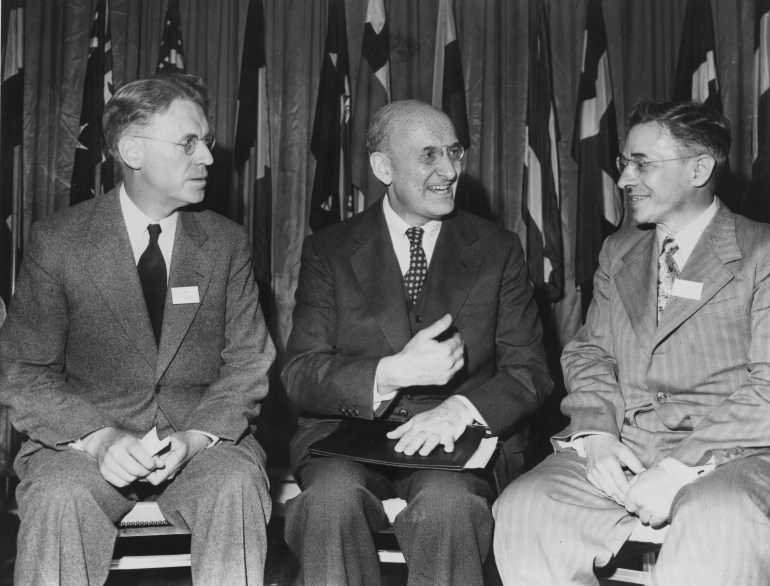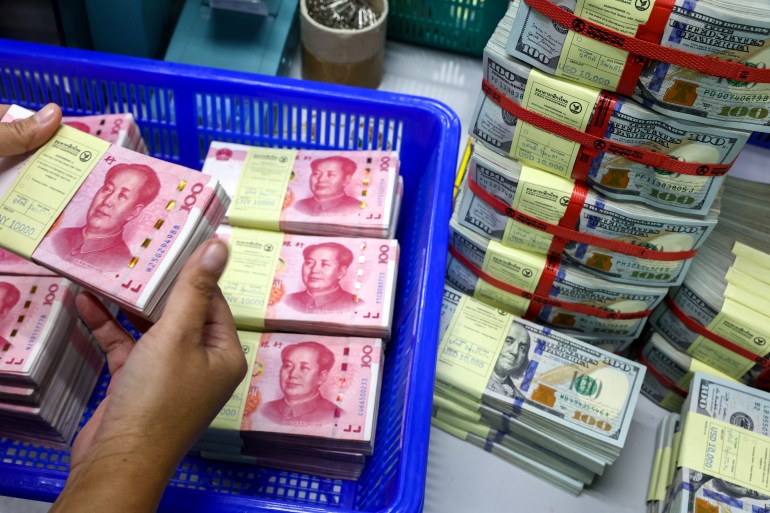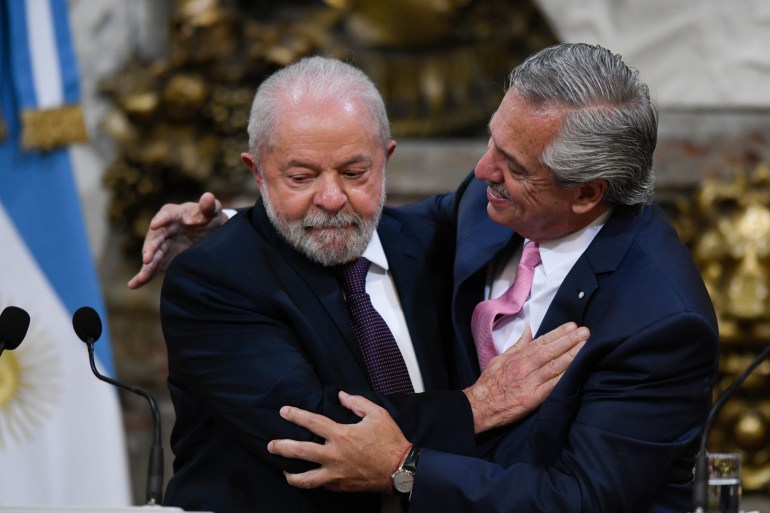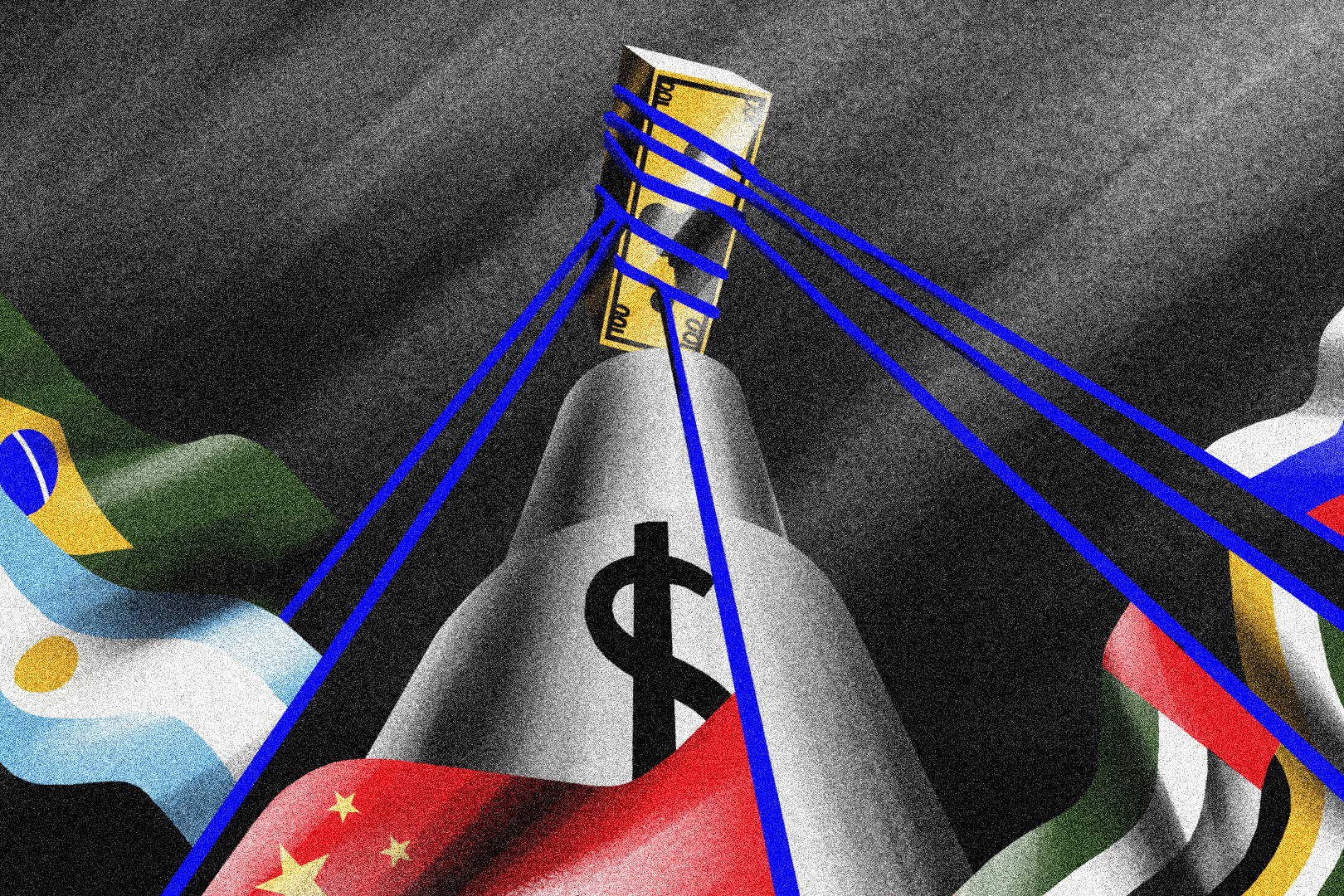A rebellion is brewing.
The United States dollar has ruled the financial world for nearly eight decades since the end of World War II. Now, another war is setting the stage for many countries to explore a move away from the dollar for trade, raising questions over the currency’s future dominance.
Russia’s invasion of Ukraine in February 2022 triggered a wave of US-led financial sanctions against Moscow. The two most powerful among them have been the decision by Western governments to freeze nearly half ($300bn) of Russia’s foreign currency reserves and the removal of major Russian banks from SWIFT, an interbank messaging service that facilitates international payments.
These sanctions, which some have called the “weaponisation” of the dollar, have predictably made Russia and China, the two biggest geopolitical rivals of the US, promote their alternative financial infrastructures.
But it isn’t just Beijing and Moscow. From India to Argentina, Brazil to South Africa and the Middle East to Southeast Asia, nations and regions have accelerated efforts in recent months towards arrangements aimed at reducing their dependence on the dollar. At the heart of these de-dollarisation initiatives is the fear in many capitals that the US could someday use the power of its currency to target them the way it has sanctioned Russia, according to political economists and sanctions experts.
So can these moves actually dethrone the currency, often referred to as ‘King Dollar’ in financial circles, from its perch as the top dog in global trade?
The short answer: The dollar’s dominance is unlikely to change in the near future, and it will remain the principal currency of international trade and transactions, analysts told Al Jazeera. No other currency is close to replacing it. But its stranglehold on the global financial system could weaken if more countries start trading in other currencies and reduce their exposure to the dollar.

How the dollar became – and stayed – king
A majority of global trade takes place in dollars, which took centre stage towards the end of World War II.
In 1944, representatives of 44 nations met in Bretton Woods, New Hampshire, to repair the world economy after the war. It was agreed that the US, as the world’s largest economy, would fix the value of the dollar to gold and other countries would in turn peg their currencies to the dollar. Countries now had to hold dollars in reserve to maintain their exchange rate, making it the dominant global currency.
The Bretton Woods regime collapsed by the 1970s because the US no longer had sufficient gold to back its dollars. Still, the dollar was by then deeply entrenched as the reserve currency used by other nations. America’s deep and flexible financial market, comparatively transparent corporate governance norms and the dollar’s stability ensured that the currency has remained dominant, even though countries are no longer obligated to fix their currencies to the dollar.
To be sure, talk of de-dollarisation isn’t new. Questions about the dollar’s dominance arose when the Bretton Woods system fell apart, when the European Union launched the euro in 1999 and then again after the 2008-2009 financial crisis.
The dollar’s dominance survived those storms. Today, nearly 60 percent of foreign exchange reserves maintained by the world’s central banks are held in dollars.
Still, that marks a decline from about 70 percent in 2000, pointing to a gradual shift within the global financial order, according to experts. While the euro’s share has gone up only marginally since its launch – from 18 percent to just under 20 percent now – China’s renminbi, also known as the yuan, has grown the fastest since 2016, even though less than 3 percent of global reserves are held in that currency.
“We are clearly moving towards a more multilateral world as shown by the falling share of the US dollar in forex reserves,” Alicia García Herrero, a senior fellow at the Brussels-based think tank Bruegel told Al Jazeera.
Over the past year, the incentives for countries to turbocharge that shift away from the dollar have only increased.

The financial world’s ‘nuclear option’
The US-led sanctions freezing Russia’s ability to use half of its reserves as well as limiting the ability of Russian banks to conduct transactions using the critical SWIFT system have spooked many countries, experts said, giving new impetus to efforts at de-dollarisation.
“The accelerator this time really is the sanctions imposed on Russia,” said Zongyuan Zoe Liu, a fellow for international political economy at the New York-based Council on Foreign Relations. She described the decision to kick Russia out of the SWIFT system as “like using the nuclear option” in the finance world.
SWIFT’s centrality in international banking is often compared to Gmail’s in the sphere of email communication. “In the integrated global financial system, this [cutting Russia off from the use of SWIFT] means you rob them off their blood vessels,” Liu told Al Jazeera.
Countries such as China, already in the crosshairs of US sanctions in sectors such as semiconductor trade, worry such measures could be used against them in the future and could impact the very functioning of their economies, analysts said.
That’s why the world’s second largest economy is “trying to actively move away from the US dollar”, Ahmadi Ali, a sanctions expert and executive fellow at the Geneva Centre for Security Policy, told Al Jazeera.
Once out of SWIFT, “you lose the ability to transact across borders easily,” he said. “You risk being cut out of the global supply chains and it could damage the economy of that country as a whole.”

Time for yuan-isation?
China has been getting rid of its US Treasury bonds, which are among the tools countries use to keep dollar reserves, It now holds $870bn in US debt, the lowest amount since 2010. It has also been negotiating deals with other countries to trade in the yuan.
In February, the central bank of Iraq, a major oil supplier, announced it would allow trade with China to be settled in yuan for the first time. Bangladesh’s central bank made a similar announcement in September. That same month, members of the China-dominated Shanghai Cooperation Organisation agreed to increase trade in their local currencies. Apart from China, the bloc consists of Russia, India, Pakistan, Uzbekistan, Kazakhstan, Tajikistan and Kyrgyzstan. And in December, China and Saudi Arabia carried out their first transaction in yuan.
Russia, meanwhile, has decided to store all its oil and gas surplus revenue in 2023 in yuan as it increasingly turns to the Chinese currency for its forex reserves.
Sanctions are not the only ways in which an overwhelming dependence on the dollar can hurt nations.
Dollar-denominated debt exposure of smaller economies and plans to boost regional trade have also led countries to move away from the dollar, Ali said. The US dollar is at a value more than 10 percent higher than at the start of the Ukraine war in February 2022 and 30 percent higher than a decade ago. At one point in October, the dollar was at its highest mark since 2000.
That appreciation in the value of the currency makes dollar-denominated debt much more expensive to repay. For countries that buy large volumes of fuel, food and other essential commodities from other nations, this also dramatically increases their import bills.
That’s why it isn’t just China and Russia trying to cut their exposure to the dollar but a flood of nations, including close friends of the US that are looking for alternatives.

Cutting out the dollar
Last week, the ambassador of the United Arab Emirates to India said the two countries were trying to finalise a deal to trade in their currencies, the dirham and rupee. The UAE is among India’s top trade partners.
In January, an Indian Ministry of Commerce official told reporters that Russia, Sri Lanka, Bangladesh and Mauritius were all keen to trade with India in the rupee.
Southeast Asia’s major economies are plotting the creation of a mechanism whereby mobile apps can be used to trade between these nations in their local currencies without needing to rely on the dollar as an intermediary.
And in an announcement that made global headlines, the presidents of Brazil and Argentina said in January that they would set up a common currency to settle trade transactions.
Despite these efforts, experts are not convinced that any currency can dethrone the dollar anytime in the near future.
“The only currency that can replace the US dollar in the long run is the renminbi, but for it to ever take up that role, the currency has to be fully convertible,” Herrero said. “I don’t think that will happen in the foreseeable future.”
A currency becomes fully convertible when it can be exchanged freely into other currencies for all purposes – in financial markets, trade or on global foreign exchange markets. However, the yuan is convertible only for limited purposes, such as trade, restricting its allure despite the ever-increasing impact of China on the global economy.
Some experts believe that while the moves towards de-dollarisation won’t replace the dollar with another dominant currency, they could carve out other options to allow non-dollar trade transactions.
Just how far they’ll succeed though is hard to tell at this point, Ali said.
Countries such as Argentina and Brazil, for instance, are commodity-based economies and the US dollar dominates commodity trading. When dealing with other countries, they will remain dependent on the dollar, Liu said. And many countries, such as Saudi Arabia and the UAE, still have currencies pegged to the dollar, she pointed out.
Escaping the dollar’s grip won’t be easy for these nations.

‘Lubricant’ or ‘weapon’?
Globally, the dollar is seen as a safe haven asset by investors, especially during economic crises, because of the high confidence in the US economy. That assurance shows in the increased demand for dollars at such times.
But that demand is also what led to the devaluation of most currencies against the dollar in 2022 during the war in Ukraine.
There are inescapable advantages of carrying out trade in a single currency, such as the dollar, Liu said. It helps reduce transaction costs and is responsible for the highly integrated nature of the global financial system, she said, calling the dollar “a lubricant in international trade and finance”. Trade in multiple currencies increases the risks of currency volatility.
A fragmented system of international trade will make transactions inefficient, Liu warned. Yet if the increasing use of sanctions cuts economies off from global finance mechanisms and supply chains, that fragmentation might become inevitable.
“If the question is whether a more diversified currency system is good or bad, I will say it’s better that we have one standard currency to do business as it has worked well so far,” Liu said. “But the condition for that would be that the United States does not weaponise the dollar.”
